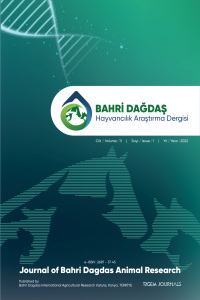Şap Hastalığının Miyokardiyal Formundan Ölen İki Kuzuda Kalp ve Dilde Gözlenen Patolojik Bulgular
Histopatoloji, immunohistokimya, şap hastalığı
The Pathologic Findings in Heart and Tongue in Two Lambs Died from Myocardial Form of Foot and Mouth Disease
Histopathology, immunohistochemistry, foot and mouth disease,
___
- Aftosa, F. (2007). Foot and mouth disease. The center for Food Security & Public Health, pp. 475-99. Erişim http://www.cfsph.iastate.edu/Factsheets/pdfs/foot_and_mouth_disease.pdf, Erişim tarihi:10.10.2016
- Alexandersen, S., Zhang, Z., Donaldson, A., Garland, A. (2003). The pathogenesis and diagnosis of foot-and-mouth disease. Journal of comparative pathology, 129; 1-36.
- Bayraktar, B. (2014). Kuzu ve oğlaklardaki miyokardiyal hasarın belirlenmesinde kardiyak troponinlerin etkinliğinin araştırılması. Adnan Menderes Üniversitesi Sağlık Bilimleri Enstitüsü, Yüksek Lisans Tezi, Aydın.
- Çiftçi, M. K., Ortatatlı, M., Erer, H., Hatipoğlu, F., Özdemir, Ö. (2015). Veteriner Sistemik Patoloji 1, Konya, SÜ Basımevi, pp. 5-8.
- Dekker, A., Nielen, M., Molendijk, M., Kroonenberg, F. (1997). Foot-and-mouth disease airborne transmission prediction model: data and model considerations. European Commission for the Control of Foot-and-Mouth Disease. Research Group of the Standing Technical Committee, Kibbutz Ma'ale Hachamisha (Israel), 2-6 Sep 1996.
- Dinter, Z., Morein, B. (1990). Virus infections of ruminants, Elsevier Science Publishers BV, pp. 506-508.
- Donaldson, A., Gibson, C., Oliver, R., Hamblin, C., Kitching, R. (1987). Infection of cattle by airborne foot-and-mouth disease virus: minimal doses with O1 and SAT 2 strains. Research in veterinary science, 43(3), 339-346.
- Dukpa, K., Robertson, I. D., Edwards, J. R., Ellis, T. M. (2011). A retrospective study on the epidemiology of foot-and-mouth disease in Bhutan. Tropical animal health and production, 43, 2, 495-502.
- Gulbahar, M., Davis, W., Guvenc, T., Yarim, M., Parlak, U., Kabak, Y. (2007). Myocarditis associated with foot-and-mouth disease virus type O in lambs. Veterinary pathology, 44(5), 589-599.
- Kitching, R., Alexandersen, S. (2002). Clinical variation in foot and mouth disease: pigs. Revue scientifique et technique-Office international des épizooties, 21(3), 513-516.
- Knowles, N., Samuel, A. (2003). Molecular epidemiology of foot-and-mouth disease virus. Virus research, 91(1), 65-80.
- Lubroth, J. (2002). Foot-and-mouth disease: a review for the practitioner. Veterinary Clinics of North America: Food Animal Practice, 18(3), 475-499.
- Mann, J. A., Sellers, R. F.(1990). Foot-and-Mouth Disease Virus. In: Virus Infections of Ruminants. Eds: Z. D, B. M. New York, U.S.A: Elsevier Science Publishers B.V., pp. 503-512.
- Milli, Ü. (2000). Sindirim Sistemi. In: Veteriner Patoloji. Eds: Milli Ü, R H. Ankara: Medipres Matbaacılık, pp. 1-239.
- Monaghan, P., Gold, S., Simpson, J., Zhang, Z., Weinreb, P. H., Violette, S. M., Alexandersen, S., Jackson, T. (2005). The αvβ6 integrin receptor for foot-and-mouth disease virus is expressed constitutively on the epithelial cells targeted in cattle. Journal of General Virology, 86(10), 2769-2780.
- Radostits, O. M. (1994). Veterinary Medicine, London, W.B. Saunders, pp. 965-974.
- Sobrino, F., Palma, E. L., Beck, E., Davila, M., De La Torre, J., Negro, P., Villanueva, N., Ortin, J., Domingo, E. (1986). Fixation of mutations in the viral genome during an outbreak of foot-and-mouth disease: heterogeneity and rate variations. Gene, 50(1), 149-59.
- Steinhauer, D., Holland, J. (1987). Rapid evolution of RNA viruses. Annual Reviews in Microbiology, 41( 1), 409-31.
- Terpstra, C. (1972). Pathogenesis of foot-and mouth disease in experimentally infected pigs. Bulletin, 77(1), 859-874.
- Windsor, M. A., Carr, B. V., Bankowski, B., Gibson, D., Reid, E., Hamblin, P., Gubbins, S., Juleff, N., Charleston, B. (2011). Cattle remain immunocompetent during the acute phase of foot-and-mouth disease virus infection. Veterinary research, 42(1), 108.
- Woodbury, E., Ilott, M., Brown, C., Salt, J. (1995). Optimization of an in situ hybridization technique for the detection of foot-and-mouth disease virus in bovine tissues using the digoxigenin system. Journal of virological methods, 51(1), 89-93.
- ISSN: 2148-3213
- Yayın Aralığı: Yılda 2 Sayı
- Başlangıç: 2014
- Yayıncı: Bahri Dağdaş Uluslararası Tarımsal Araştırma Enstitüsü
Yumurtacı Tavuk Gönenci (Refah) ve Avrupa Birliği Sürecinde İlgili Mevzuatın Karşılaştırılması
Şap Hastalığının Miyokardiyal Formundan Ölen İki Kuzuda Kalp ve Dilde Gözlenen Patolojik Bulgular
Mustafa Kemal ÇİFTÇİ, Muammer İNANÇ
Neonatal Dönemde Nutrisyonel Miyopati Kaynaklı Kuzu Ölümleri Üzerine Patolojik İncelemeler
